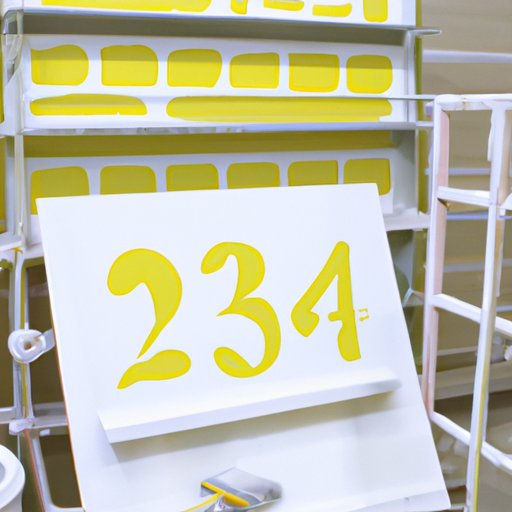Introduction
When it comes to painting a surface, one of the most important aspects of the process is understanding how long to wait between coats of paint. The amount of time needed can vary greatly depending on the type of paint being used, the substrate, humidity, temperature, and other factors. This article will explore all of these elements in order to give readers a better understanding of how long to wait between coats of paint.
Analyzing the Different Types of Paint and Their Drying Times
The type of paint being used will have a significant impact on the amount of time needed between coats. Oil-based paints tend to take longer to dry than latex paints. Oil-based paints typically require at least 8 hours of drying time before a second coat can be applied. Latex paints are generally much faster, with a drying time of about an hour or two. Other types of paint, such as acrylics, may require even less time between coats.

Exploring the Various Factors That Influence the Time Between Coats
In addition to the type of paint being used, there are a number of other factors that can influence the amount of time needed between coats. The substrate, or surface being painted, can play a role in determining the time needed. For example, if the surface is highly absorbent, it may require more time between coats. Humidity and temperature can also affect the drying time. In humid environments, paint can take longer to dry, while in hot and dry conditions, the drying time may be reduced. The thickness of the paint can also make a difference, with thicker coats requiring more time between applications.
Examining the Benefits of Waiting Longer Between Coats of Paint
Waiting longer between coats of paint has several benefits. One of the primary advantages is improved adhesion. By waiting longer, the first coat of paint has a chance to dry completely, which helps ensure that the second coat will adhere properly. Additionally, by waiting longer, it reduces the risk of bleeding or blistering, which can occur when the second coat is applied too soon. Finally, waiting longer between coats can also result in a deeper color, as the paint has more time to fully cure.

Investigating the Different Techniques for Ensuring Proper Adhesion of Paint
In order to ensure that the paint adheres properly, it is important to follow certain techniques. The first step is to prepare the surface, which may involve sanding, cleaning, priming, and filling in any cracks or holes. Applying a quality primer is also beneficial, as it acts as a base for the paint and helps it to adhere better. Finally, using a quality paint brush is essential for achieving a smooth, even finish.

Comparing the Time Requirements for Interior vs Exterior Painting
The amount of time needed between coats of paint can also vary depending on whether the painting is taking place indoors or outdoors. For interior painting, it is typically recommended to wait at least four hours between coats. For exterior painting, the wait time may be slightly longer, as the paint needs to dry completely before any inclement weather arrives.
Exploring the Role of Temperature in Determining the Ideal Wait Time Between Coats
Temperature is another important factor when it comes to determining the ideal wait time between coats. Generally speaking, the higher the temperature, the faster the paint will dry. However, extreme temperatures can cause the paint to dry too quickly, resulting in cracking or bubbling. To prevent this from happening, it is best to keep the temperature within the manufacturer’s recommended range.
Conclusion
In conclusion, it is important to understand how long to wait between coats of paint in order to ensure a successful painting job. The type of paint being used, the substrate, humidity, temperature, and other factors can all play a role in determining the ideal wait time. Additionally, preparing the surface, applying a quality primer, and using a quality paint brush can help ensure proper adhesion. Finally, the wait time between coats can vary depending on whether the painting is taking place indoors or outdoors, and extreme temperatures should be avoided.


